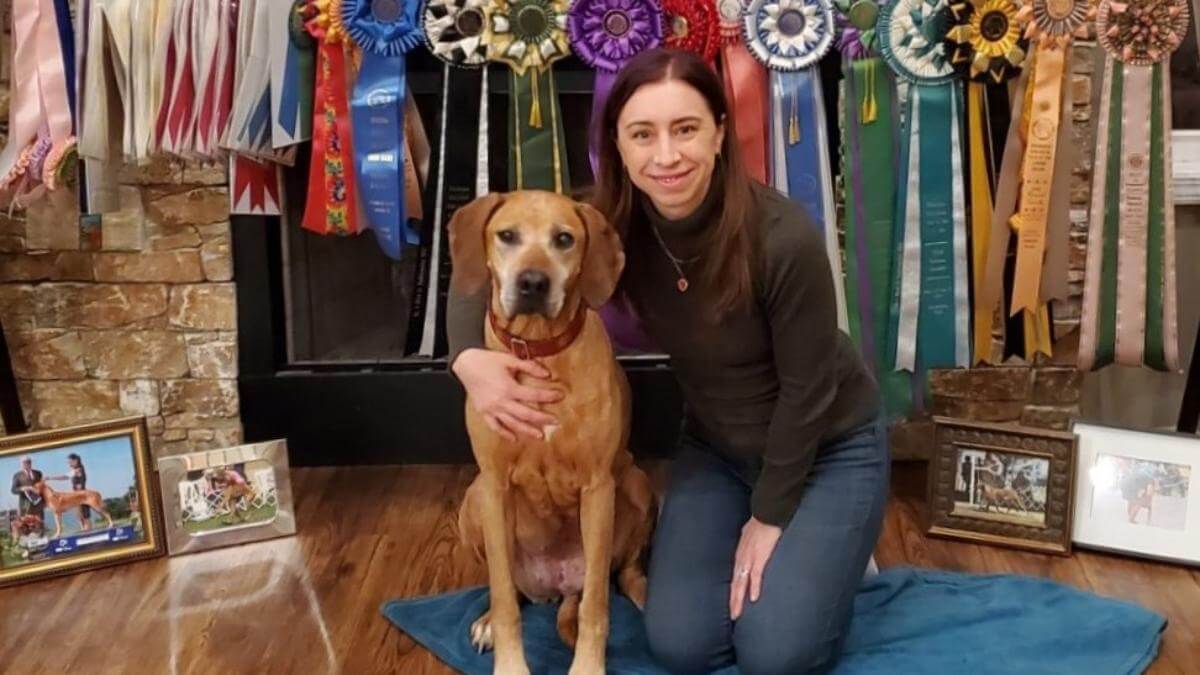
Home » Marie Glodowski | Zareba

Marie Glodowski
1. I am Marie Glodowski and my husband, Marcin, and I, along with our two children, Sonia and Maksym, call Belleville, Michigan, our home. My journey in the world of dogs began 32 years ago, in 1993, when I attended my first show with Tea Cooper, who became my mentor. I proudly inherited her kennel name and soon after embarked on Junior Showmanship. In 2006, I bred my first Zareba litter, and since then, I’ve had the privilege of producing more than 40 Champions and Performance-titled dogs. I’ve also recently been approved to judge Rhodesian Ridgebacks and Juniors. Lauren Michaels is also an integral counterpart of Zareba; we truly thrive as a team!
2. The defining feature of the Ridgeback is, of course, its distinctive ridge, which runs in the opposite direction of the light-to-red wheaten coat, stretching from the shoulders to the pelvis. This ridge is characterized by two symmetrical crowns and a fan-like formation near the top of the ridge. Without it, the Ridgeback would resemble just another generic brown dog. Maintaining a balanced outline is crucial, with the tail carried smoothly off the back when in motion. An improper tail set or carriage can disrupt the correct breed type, affecting both the dog’s outline and breed type while moving.
3. Our experience of placing puppies in loving homes has been overwhelmingly positive. We consistently have strong demand to support breeding a litter. We keep a wait list, where some people don’t mind waiting several years for one of our dogs, and we have many repeat homes. We prioritize ongoing communication with our current puppy families and, most importantly, uphold the highest standards for temperament in our dogs. When our puppies transition to their new homes, they serve as ambassadors of our breed, our bloodline, and our dedication to socialization. We are committed to ensuring that Zareba puppies grow into healthy, well-adjusted companions who, in turn, generate further interest in our dogs, including future puppy homes.
4. We thoroughly screen our breeding candidates for all required OFA (Orthopedic Foundation for Animals) testing, along with optional evaluations such as shoulders, patellas, and degenerative myelopathy. We also utilize Embark as a DNA tool to identify potential genetic concerns within our breed. Our commitment to continuous education, and staying informed on breed-specific health issues, enables us to make responsible breeding decisions and improve hereditary conditions that may affect our dogs. In addition, we have performed advanced cardiac screening and Holter monitoring for RR-IVA.
Transparency is key in our interactions with puppy homes, and we prioritize education regarding any health concerns we’ve encountered. To foster communication and connection, we maintain a website and social media groups/pages on Facebook and Instagram; these have proven to be valuable resources for puppy owners and the broader public.
5. Experienced and knowledgeable dog enthusiasts understand the qualities they seek in a well-bred purebred. However, public perception of purebred dogs remains varied, influenced by location and individual perspectives. With the explosion of “doodles,” many owners believe they are investing in a high-quality dog, despite the lack of health or temperament testing. A common misconception suggests that mixed breeds are inherently healthier simply because they are not purebred. Unfortunately, many people are unfamiliar with what truly defines a well-bred dog versus a backyard-bred one, let alone the distinctions between inbreeding, line-breeding, outcrossing, health testing, and earning titles. Education and increased public exposure to responsibly bred purebreds play a crucial role in raising awareness across all breeds, many of which could be the perfect match for individuals if they simply knew where to look and what to look for.
6. Something I’ve noticed, but maybe not a trend, is a lack of newcomers seeking mentorship and knowledge. While the Internet offers a valuable resource for research, connecting with experienced, senior members of our sport remains crucial to understanding the challenges that have shaped our breed over the decades. Meaningful mentorship across all aspects of the dog world is vital for learning, refining skills, and strengthening the foundation upon which breeding programs are built.
7. One of the most positive changes I’ve seen in our sport is the growing emphasis on Junior Showmanship. Juniors play a vital role in keeping youth engaged, helping clubs thrive, and fostering enthusiasm and education in dogs, animal husbandry, and competition. The AKC (American Kennel Club) has significantly improved recognition for Junior Showmanship through dedicated events and expanded competitive opportunities, including Agility, Lure Coursing, Obedience, and Field Trials—along with scholarships, prize offerings, Pee Wee programs, and handling clinics. These initiatives provide a tremendous gateway for young enthusiasts to get involved and develop a passion for dogs. I only wish such opportunities had been available when I was a Junior!